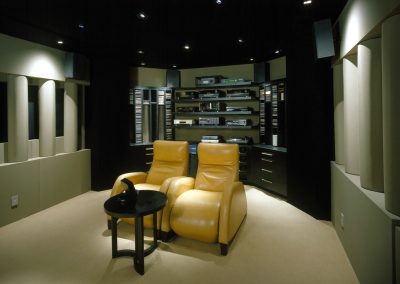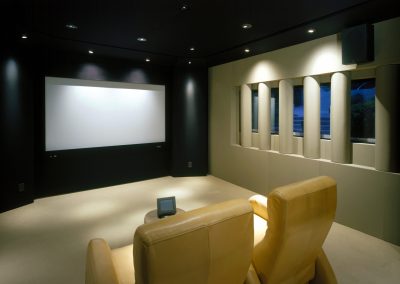by Dan Daley
SystemsContractor News
Music library Firstcom founder Jim Long is still a music business executive, as CEO of One Music. When he purchased beloved puppeteer Shari Lewis’ former residence in Malibu, north of Los Angeles, he needed a professional-level screening room that would double as a critical listening environment for music. And he needed to have it fit into a relatively small-approximately a 20 x 15-foot-space. Oh, and keep the window there, too. Nice view.
That was the challenge Carl Tatz, principal of Nashville-based Carl Tatz Design, took on earlier this year. Long wanted a high-end system capable of 5.1 playback for critical music listening as well as a 7.1 surround system for home theatrical applications, and there was only one space in the home where it made sense to locate it. “The room was a challenge,” said Tatz, a former recording studio owner who previously had designed a 5.1 production room for Long in Nashville and a media room in the CEO’s Beverly Hills residence. “One side had a window, and the other was open to the rest of the house. Plus, there was a vaulted ceiling and 45-degree angles in a all four corners, so there were a lot of acoustical and construction issues to deal with first.”
Working with the renovation architect, Tatz had the open side if the room walled up, calculating it to symmetrically match the rest of the room. He designed and installed a tray-type ceiling cloud membrane, packed with Owens-Corning 703 and 705 insulation, which floats below the ceiling, with a 6-inch perimeter, addressing the acoustical issues there and also acting as a vent less input from the air-conditioning unit on the roof, (As per Malibu tradition, the home has no central AC.) Tatz said he got lucky with the flooring; “The house uses radiant heating and has bamboo-type flooring. That meant that there was a flexible floor, which really helps give a small room more bass resonance and response. When you hear the explosions in a film, you’ll also be able to feel them, too. At the same time, the ceiling treatment helped us with the issue of height-mode standing waves by giving us more low-end absorption.”
The window was addressed by putting several ASC Tube Trap half-round absorbers along it, creating what Tatz describes as “an acoustic lens,” which blunts the reflective properties of the window with diffusion while still letting in natural light. He also mimicked the same type of acoustical array on the opposite wall to maintain acoustical symmetry.
The room is fitted with an array of top-tier electronics and based around a JBL Synthesis 3 system, customized for the dual music and home theater applications. In critical listening mode, the Synthesis’ tweeters turn on; in movie mode, the system switches to horns. To accommodate the 7.1 array, Tatz added four JBL dipole-type speakers, running through a pair of Bryston 3B-ST amplifiers and four channels of Symetrix 552E parametric equalizers, since the Synthesis system didn’t have enough channels to accommodate eight channels of playback. The system’s two 15-inch subs are from JBL Synthesis 2 systems.
Long can toggle between the two environments using an Elan remote-control system, programmed by Robert Hancock, of L.A. based Savi. In music mode, the tweeters and dipole speaker work in tandem; in home theater mode, all eight channels play and the horns are engaged.?The screen is a 100-inch-diagonal Stewart Ultimate 4-way masking using Grey-hawk perforated screen fabric, allowing a realistic cinematic experience with the center speaker behind the screen. The projector is a JVC DLA- RS20 with a DVDO video processor, producing an image sharp enough to be viewed in daylight.
“The great thing is that there’s a lot of technology to draw on that can let you put a lot of theater in a relatively small amount of space,” Tatz said. “And you don’t have to compromise on the sound or the picture.”



